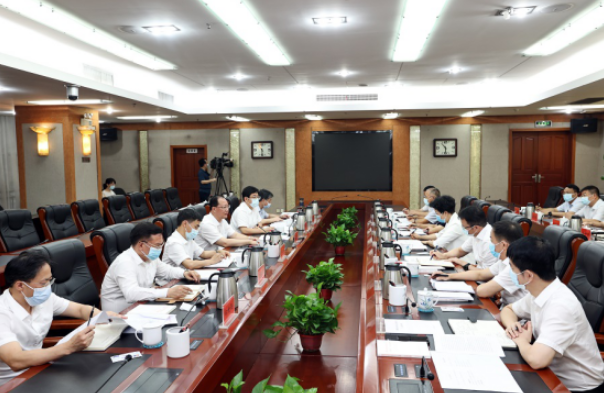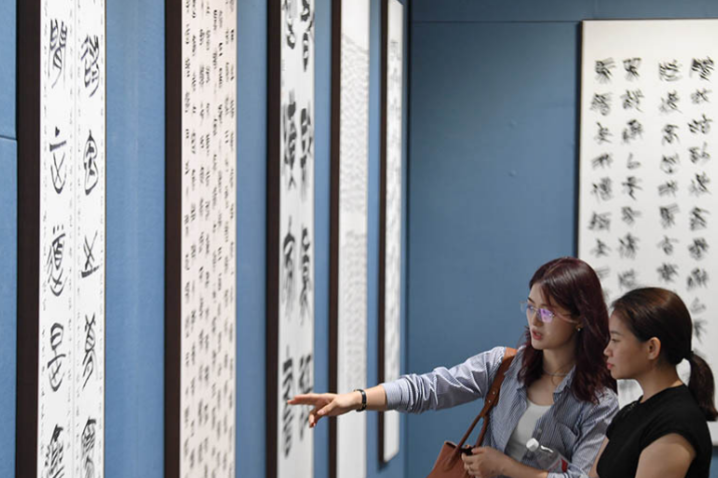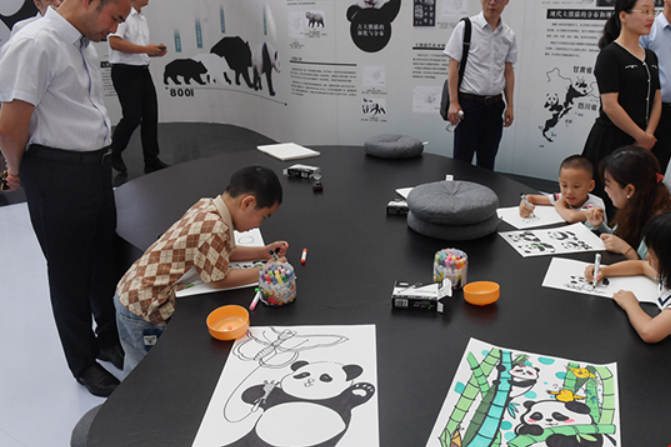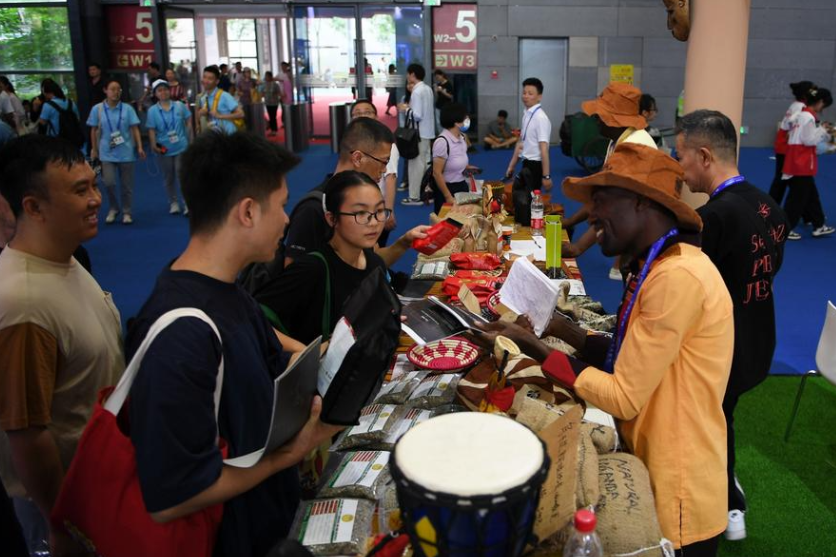Editor's note: Chinese culture has a long history and is different from the cultures of other countries. In recent years, with rapid economic development and increasing trade and people-to-people exchanges, Chinese culture has caught the imagination of people in Western countries. Four experts share their views on the issue with China Daily. China's cultural industry has unprecedented opportunities to advance its development thanks to the country's high-quality economic development, the evolution of the principal contradiction between unbalanced and inadequate development and the people's ever-growing needs for a better life, and the gradual advancement of reform and opening-up. To begin with, the quality and competitiveness of China's cultural industry have improved, developing from spontaneous movement to proactive promotion to make remarkable achievements over the past decades. Also, the scale of the cultural industry has been expanding. National Bureau of Statistics data show that the added value of China's national cultural and related industries in 2022 was 5.37 trillion yuan ($753.5 billion), accounting for 4.46 percent of GDP — the figure was only 1.10 trillion yuan in 2010. According to a nationwide survey, the operating revenue of 69,000 cultural and related industrial enterprises above designated size in 2022 was 12.18 trillion yuan, up 0.9 percent year-on-year. The quality of the cultural sector, too, has been improving. Besides, new types of cultural industries including digital publishing, entertainment drones and wearable devices have seen double-digit growth. Plus, the country is increasing cultural exports and adopting a more open approach to culture to promote cultural trade and investment. It is clear therefore that the cultural industry has new development opportunities, with booming consumption having the potential to drive the supply of high-quality cultural products. The evolved principal contradiction in Chinese society also reflects the people's demand for better cultural products and services. High-quality development has boosted consumption demand as people are spending more on education, and cultural and entertainment products and services. In particular, people's demand for cultural and tourism products are increasing significantly. As such, industries need to undergo structural reform to be able to meet people's new demands for cultural and tourism products and services. As an economy achieves higher-quality development, it tends to shift its focus from primary to secondary and tertiary sectors. Accordingly, the industrial structure, too, shifts its focus to the service sector. According to statistical bulletins of the Ministry of Human Resources and Social Security, at the end of 2022, the number of people employed in China was 733.51 million. With 459.31 million employed people, urban areas accounted for 62.6 percent of the total. Notably, 24.1 percent of the people were employed in the primary sector, 28.8 percent in the secondary sector and 47.1 percent in the tertiary sector. In 2012, the secondary and tertiary sectors accounted for 30.3 percent and 36.1 percent, respectively, of the total workforce, reflecting the country's shifting emphasis from the primary and secondary sectors to the tertiary sector, which is becoming a major driver of economic growth. And as part of the tertiary sector, the cultural industry can promote common prosperity and the well-being of the people. In fact, the development of the cultural industry can meet the intellectual and cultural needs of the people, as well as provide flexible employment opportunities for the people, with the digital transformation prompting young people to start their own business. As a matter of fact, China's cultural industry can now act as a bridge for cultural exchanges. Normally, a country with a higher-quality and unique cultural industry has stronger cultural influence and competitiveness in the global markets. It should be mentioned here that China's cultural industry has been helping boost cultural exports in recent years, with Chinese cultural products becoming an important part of the country's cultural trade, which in 2022 reached $220 billion, up about 11 percent year-on-year, according to the Ministry of Commerce. China's export of TV dramas, internet literature, audio and video clips, and other creative products are growing at a fast pace, with high-quality cultural products and services better meeting society's diversified demands. According to the China Game Industry Report, the country's actual sales revenue from self-developed games in the overseas market in 2022 totaled $17.3 billion. Besides, China Writers Association report showed that more than 10,000 Chinese internet literature works had been released overseas by 2020, becoming the biggest source of intellectual property for Chinese cultural works introduced abroad. The works included more than 4,000 authorized and printed books and over 3,000 online translation works, while related websites and apps have attracted more than 100 million subscribers from across the world, according to the report. And China-based new media platforms, along with competitive cultural enterprises and products, can better spread Chinese culture and stories abroad, as their tailor-made contents can meet the demand of foreign users, and make China's voice heard on the global stage. Civilizations today are more interconnected than ever before, the destiny of the people around the world is more closely linked and the international community agrees that civilizations should be inclusive and jointly promote development. Yet the "clash of civilizations" theory, which claims "principal conflicts of global politics will occur between nations and groups of different civilizations", had been in vogue until recently. With the end of the Cold War, international relations are no longer confined to the study and interpretation of a single event or delimited by ideology, and more attention is being paid to global trends. While new ideas and theories are emerging to guide the world in the right direction, certain people are working their fingers to the bone to label some countries as opponents and rivals of the United States, which, incidentally, seeks unipolar domination. It is in this context that Harvard political scientist Samuel Huntington developed the "clash of civilizations" theory, which has three main characteristic features. First, in the new era, the leading cause of human disputes and conflicts will be the difference between civilizations and cultures. Second, the differences between civilizations and cultures are not only real but also fundamental. And third, economic globalization and regionalization have prompted civilizations to play a greater role in international relations and increased the possibility of conflicts among civilizations. The different views on inter-civilization relations reflect Huntington's personal global view and civilizational views. According to Huntington, the non-Western challenge to the West at the peak of power is growing, and the probability of a "clash of civilizations" has greatly increased, concluding that the major global conflicts in the future will be between countries and groups with different civilizational backgrounds. "In this new world the most pervasive, important, and dangerous conflicts will not be between social classes, rich and poor, or other economically defined groups, but between peoples belonging to different cultural entities," Huntington claimed. Based on a fallacious assumption, Huntington emphasized that the main line of political conflicts in the post-Cold War world would be "clash of civilizations", a claim that is far removed from constructive theory and policy practice. The introduction of civilization as an important variable to the study of international relations was originally an academic matter; it has helped deepen and broaden the international political theory. However, there is no basis for elevating "civilization" to a position more important than national and economic interests. History shows the "clash of civilizations" theory is wrong, and it is foolish to assume one's own civilization is superior to others. The international academic community has made no secret of its doubts over the "clash of civilizations" theory. Academics have questioned Huntington's one-sided emphasis on the conflict and antagonism between different societies and civilizations. For example, how do we evaluate the roles of economic globalization and modernization of communication in increasing exchanges and integrating interests among countries? Should a country face the important common global challenges alone or should all countries join hands to cope with them? Neither Huntington nor the proponents of his theory have provided convincing answers to such questions. Since Huntington firmly holds the Western position, his theory is rooted in Western-centrism and dictated by the hegemonic power politics and zero-sum game thinking of some people in the US and other Western countries. More important, it has been made part of the strategic scheme of containing the development of emerging economies and developing countries such as China, and making non-Western countries weak. There are more than 200 countries and regions, diversified ethnic groups and many religions in the world. These countries have different histories, cultures and social systems, which are the inherent features of a civilization. There can be no civilization without diversity, and diversity will continue to exist for as long as humans exist. There is a need for countries to follow the global development trends, promote civilizational concepts that emphasize equality, mutual learning, dialogue, and inclusiveness. They need to respect each other and treat each other as equals, accept the civilizational diversities, respect the differences in political systems, and draw on each other's strengths to explore new grounds in development, so as to contribute to the progress of civilization. In March 2023, China proposed the Global Civilization Initiative, stressing that we respect the diversity of civilizations and the common values of humanity, understand the importance of inheritance and innovation of civilizations, and promote people-to-people exchanges and cooperation globally. The GCI has contributed Chinese wisdom to promote inclusive coexistence, carry out exchanges and facilitate mutual learning among different civilizations. The absurdity of the "clash of civilizations" theory demonstrates the great significance of the GCI and the correctness of its theoretical basis. Therefore, all countries should promote global peace and development, strengthen civilizations, boost international exchanges and cooperation, explore innovative measures to establish a global network of dialogue and cooperation among civilizations, foster mutual understanding and amity among peoples, break down the spiritual barriers that hinder human exchanges, and work together to ensure the harmonious coexistence of different civilizations and the continuous progress of civilizations toward a bright future. Chinese culture has a rich history of 5,000 years. It is closely linked to the Chinese language, and facilitated the emergence of Chinese literature, and documentation in the form of written records and printed books. Books are closely linked to the rise and fall of a culture. Even in the downfall of a society, the historical facts are recorded in writing in order to provide posterity with the evidence of the achievements, failures and the reasons for the downfall of that society. Chinese culture is unthinkable without these written testimonies, which are not only cultural expressions of self-assurance and representation but also artifacts of self-reflection. Literature and culture therefore have a relationship of reference. Chinese culture owes its raison d'être primarily to three main philosophies, Confucianism, Taoism and Buddhism, all of which could be considered to have gone through five phases. The earliest phase can be traced to before the unification of China and was primarily concerned with social issues. In the second phase, the worldview was primarily to make projections for consideration, while the third phase had an ontological approach that dealt with the being, the I. The fourth phase was concerned with idealism, which is the diametrically opposite of materialism, realism and empiricism. In the European context, Plato and Descartes are worth mentioning, because they accord fullness to the being to ideas. The fifth and last phase is characterized by gnoseology, which deals with questions about the prerequisites for knowledge, and how knowledge is acquired. In addition, the truthfulness of certainty and justification are questioned and doubts raised about certain desirable beliefs. This still continues, although Confucianism is placed alongside it because it is constitutive of China's identity and culture today. The duality of learning according to Confucius' concept is still valid today, because it means "learning for others" and "learning for yourself", meaning one cannot do without the other. Only through learning can ren, which means something like "thoughtfulness" and the difference between humans and animals, be determined. No wonder many countries have agreed to set up Confucius Institutes whose main task is to promote the concept of learning from each other and create space for fruitful cultural exchanges, which, first of all, requires overcoming foreignness by transferring what is foreign into what is familiar so that one can enrich oneself by what is foreign. Unfortunately, there still exists a tendency in many to trivialize the foreignness of other cultures, including Chinese ones, so that the foreign is subsumed under an universalistic model of humans in general, making it quite difficult to deny a Euro-American-centric perspective. The philosophy of alterity is of crucial importance in this context, as one must assume that the fundamental "givenness" of human existence and the response to the other is a prerequisite for the constitution of one's own, the I. Palestinian academic and literary critic Edward Said made an important contribution to the understanding of post-colonial culture with his book Orientalism: Western Conceptions of the Orient. The orient here includes China. Said sparked an important discussion by criticizing the perspective of culture and images of the other in the European-American cultural space. He was against the binary opposition: positive/negative, which Georg Wilhelm Friedrich Hegel also advocated in the case of China. In his eyes, this is an unacceptable, distorted perception of others and their cultures that needs to be changed. An equal dialogue among all cultures, especially the extremely demanding Chinese culture, is not only important but also necessary, because we have to realize that European-American culture, together with the cultures of other industrialized countries, still dominate the global discourse. The history of humanity shows that the flowering of one culture sometimes went hand in hand with the rejection of other cultures, especially as a separation of one from the others, as was the case with the Greeks and Romans. This culture was often forced upon others through open colonization to prove the superiority of one set of people and culture over other peoples and cultures, leading to economic and military oppression of peoples of what today can be called the Global South. Cultural exchanges can help promote harmony and peace between peoples, because regardless of the ethnicity, language, culture, history, customs and social conditions, the mere existence of a person is constitutive of self. As Aristotle said: "A unity must derive from a multitude."
Cultural industry can better tell China story
Editor:樊令钰
Source:chinadaily
Updated:2024-01-08 17:09:04
Source:chinadaily
Updated:2024-01-08 17:09:04
Special
Contact
Welcome to English Channel! Any suggestion, welcome.Tel:0731-82965627
lisl@rednet.cn
zhouqian@rednet.cn











